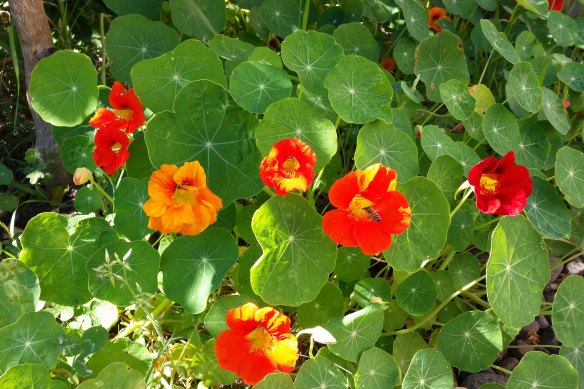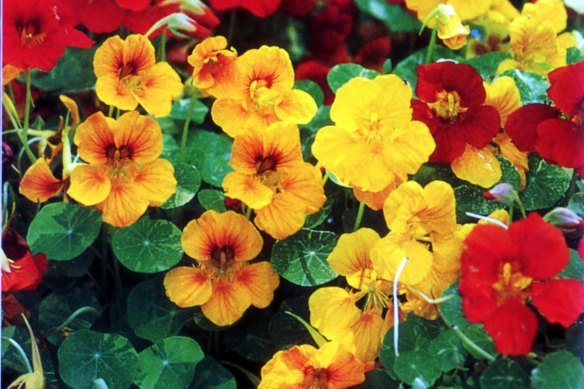I’m sure I’m not the only person who left the Cressida Campbell exhibition at the National Gallery of Australia in Canberra with a determination to rearrange the kitchen bench – and pick a bunch of nasturtiums.
Fortunately I could do both, thanks to the crappy Airbnb I booked last spring. The house only glancingly resembled the photos that had sucked me in and would have been miserable were it not for a mob of cheering nasturtiums gambolling up the weedy rise out the front and dancing through the metal fence and onto the broken and chipped brick terrace.

Nasturtiums are beautiful and delicious.Credit:Mark Garnham
Soon the dusty interior was transformed as afternoon light slanted through a big glass bowl of nasturtium flowers and leaves and the air took on their distinctive spicy perfume. They made me so happy I immediately ordered a packet of seed and planted it as soon as I got home.
Nasturtiums are not often available as seedling plants because they don’t transplant well. But they are easy to grow from seed, as the seeds are big and are best sown where you want them to grow. That should be somewhere with plenty of sun, reasonable drainage and not particularly fertile soil.
Too many nutrients make them produce plenty of leaves and a sparse sprinkling of blooms, so they are perfect for spots where other flowering annuals don’t do well. For best results sow them in spring and early summer for a show that starts in late spring and continues through autumn. To speed germination, soak them in lukewarm water overnight before sowing.
The trailing, scrambling types do well tumbling up or down banks, rambling over path edges or looping around a hanging basket. These are the kind that Claude Monet planted, and painted, at the edge of his big flower borders in front of his house at Giverny. If that riotous growth is a bit too messy for your aesthetic, there are other varieties that are denser and will stay in a relatively neat mound.

Nasturtiums are bright and grow well in the sun.Credit:Fairfax Media
Colours range from soft lemon, through gold and orange and into reds and burgundies. Some have variegated leaves. Order through your favourite seed supplier.
Nasturtiums are fully edible. Both the flowers and the leaves have a strong peppery taste and though they look good in a salad I think there are more delicious things to grow to eat. More importantly, any nasturtium you eat is one less to enjoy in a jar on the kitchen bench. This is one of those plants that rewards the greedy, as picking the blooms encourages more.
Stay connected with us on social media platform for instant update click here to join our Twitter, & Facebook
We are now on Telegram. Click here to join our channel (@TechiUpdate) and stay updated with the latest Technology headlines.
For all the latest Life Style News Click Here
For the latest news and updates, follow us on Google News.
